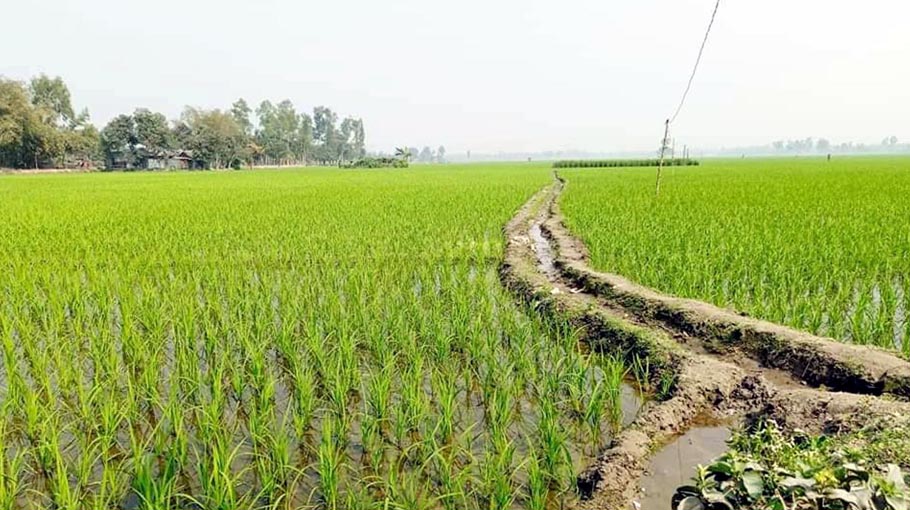Teesta Irrigation Project makes huge contribution to agro sector

Boro paddy has been cultivated in five lakh five thousand 235 hectares of land in five districts of Rangpur agricultural region this season. It is expected to produce 22 lakh 7 thousand 132 metric tonnes of rice. Out of which, three lakh metric tonnes will be produced under Teesta Irrigation Project.
According to the concerned sources, the lack of irrigation water in large areas of North Bengal has led to various crises in crop cultivation. In the dry season, there is a crisis in rain-fed Aman cultivation due to drought. The flow of water in small rivers and canals other than Teesta is very low. Therefore, the need for irrigation projects in the region through the construction of barrages on the river Teesta arose during the British period. The largest barrage in Bangladesh was constructed under the Teesta Barrage Project (Phase I) at Dalia in Nilphamari and Doyani in Lalmonirhat district. While in other areas due to lack of rains, there is a cry for irrigation water, in the command area of Teesta Irrigation Project, the farmers are producing bumper crop by getting the required irrigation facility at low cost.
Boro paddy cultivation is going on at present. Boro cultivation is targeted at 53,000 hectares of land with Teesta water. This includes 31,000 hectares in Nilphamari district, 15,000 hectares in Rangpur district and 7,000 hectares in Dinajpur district. But within the stipulated time, it has been possible to cultivate Boro in at least 60,000 hectares of land under the project.
At the Teesta Barrage Command area, the seedlings planted before getting irrigation facilities as per the demand in the field are growing dark green in color. Abbas Ali, a farmer from Dundibari area of Jaldhaka upazila in Nilphamari, said that under the project, the cost of irrigating land is Tk 480 per acre in three seasons of the year (Aush, Aman, Boro). As such, it costs only 180 Tk to irrigate one acre of land during the Boro season. Five thousand to six thousand Tk is to be counted outside the project. Mentioning that he himself has cultivated Boro on one acre (three bighas) of land with irrigation canal water, Abbas Ali said that it is more profitable to cultivate paddy in Teesta irrigation water at low cost.
Read More: Agro sector has huge potential in coastal areas
This time, the farmers of Chirirbondor area of Dinajpur, 65 km away from Teesta Barrage, are also getting full irrigation. Farmers of the project area including Ahad Ali, Sirajul Islam and Nripendra Nath of Ganjipur area of Gangachara upazila of Rangpur said that the farmers of Command area are benefiting from Teesta irrigation due to high cost of fuel and electricity. "Teesta irrigation has been a blessing to us," they said, recounting success stories of irrigation crops over the past few years.
Aminur Rahman, president of the Teesta Irrigation Canal Water Management Association, said irrigation water has brought great success to winter crops including Boro and maize. Noting that the farmers are producing low yielding crops at low cost as there is no shortage of irrigation water this year, he said that this time 242 water management teams have been formed among the beneficiary farmers of the three districts to avail Teesta irrigation facilities. These groups mainly distribute water to the farmers of Nilphamari Sadar, Dimla, Jaldhaka, Kishoreganj and Syedpur, Sadar of Rangpur district, Badarganj, Taraganj and Gangachara and Parbatipur, Khansama and Chirirbandar of Dinajpur district. In this process irrigation can be provided easily including water distribution.
According to the investigation, the Teesta Barrage Irrigation Project has the capacity to irrigate 16,000 hectares in 2014, 10,000 hectares in 2016, 8,000 hectares in 2016, 35,000 hectares in 2016 and 40,000 hectares in 2019 and 53,000 hectares in 2021. This year, the target of irrigating 53,000 hectares of land has been exceeded. Rafiul Bari, Extension Officer, Teesta Barrage Irrigation Project, said: Irrigation is being provided in 12 upazilas of three districts by rotation system. As a result, about three lakh metric tons of boro paddy is expected to be produced in the command area of the irrigation project. Which could play a significant role in the agricultural economy of the region.
Additional Director General of Water Development Board Engineer Jyoti Prasad Ghosh said that although it is possible to irrigate about 80,000 hectares of land this time, the Ministry of Water Resources has taken initiative to increase its perimeter. The Teesta Irrigation Project has revolutionized agriculture in the north. The Water Development Board has undertaken a special project to construct 650 km long secondary and tertiary irrigation canals to supply irrigation water to the grassroots level of one lakh 16 thousand hectares of land in the command area of the project. The cost has been estimated at one thousand 465 crore.
As a result, the production of additional one lakh metric tons of paddy will increase annually. At the same time the production of other food grains will increase by about five lakh metric tons. Its current market value is one thousand crore rupees. This will further improve the ground water level, protect the environment and biodiversity and improve the socio-economic condition of 3 million people living in the project area. The project will be implemented till June 2024.
Meanwhile, sources in the Rangpur Regional Office of the Department of Agricultural Extension said that the target for boro cultivation has been set at five lakh three thousand 550 hectares of land in the Rangpur agricultural area this season. Of these, 61,550 hectares are in Nilphamari, one lakh 30,950 hectares in Rangpur, one lakh 26,745 hectares in Gaibandha, one lakh 15,555 hectares in Kurigram and Lalmonirha.




